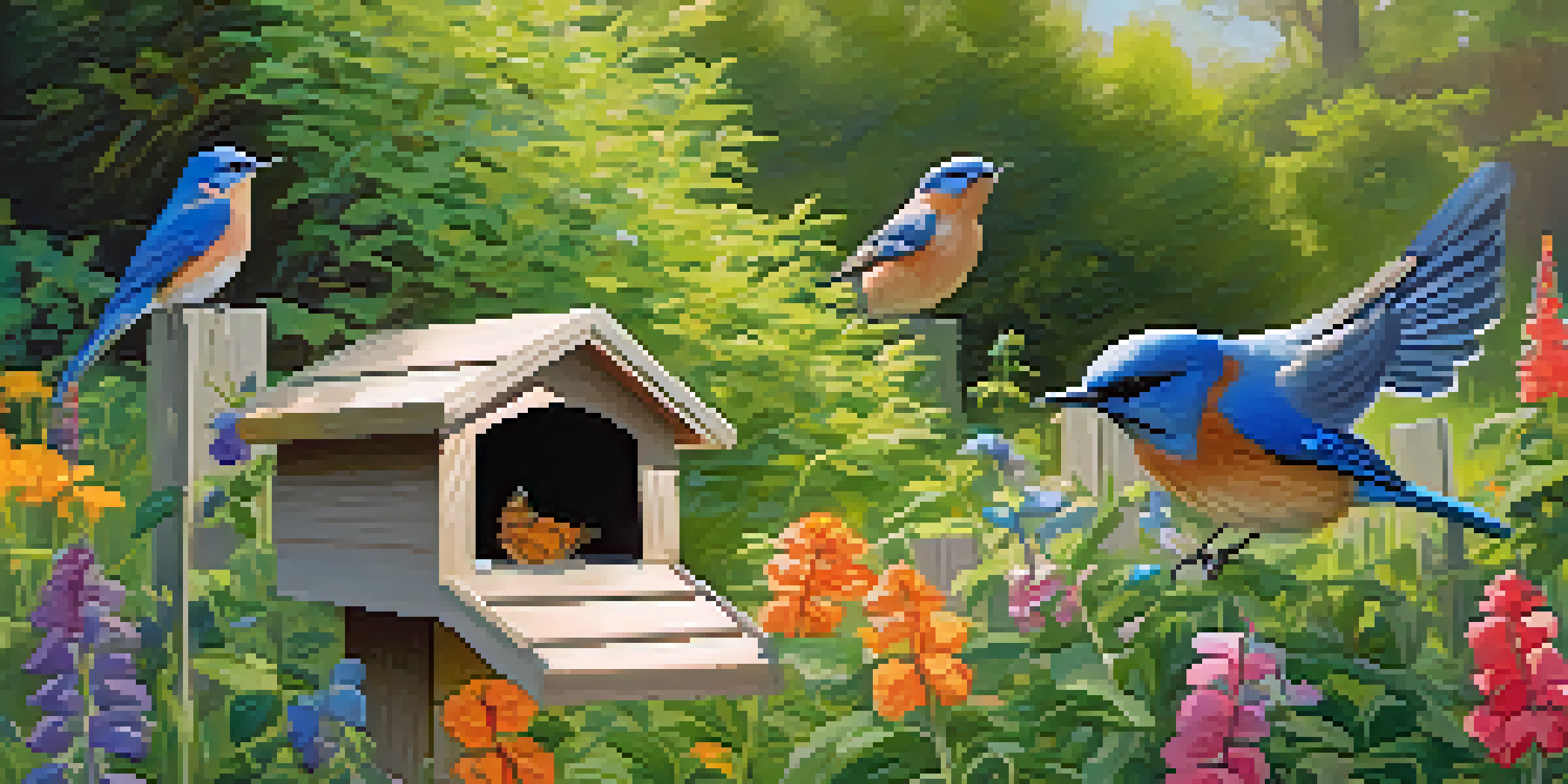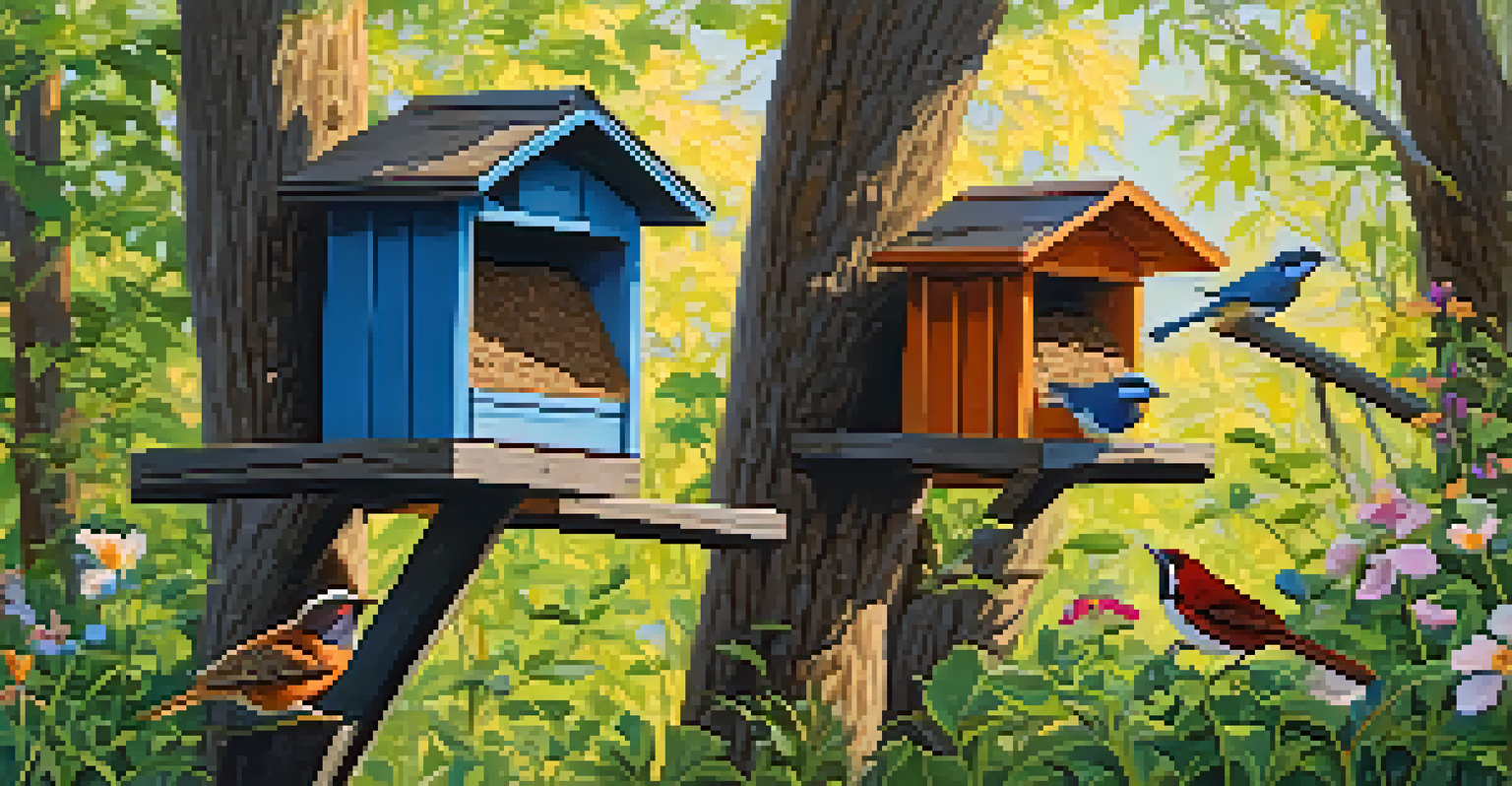How to Create Nesting Sites for Local Birds in Your Garden

Understanding the Importance of Nesting Sites for Birds
Nesting sites are crucial for birds, serving as safe havens for raising young. Just like humans, birds need secure and comfortable places to lay their eggs and nurture their chicks. Providing these sites not only supports local wildlife but also enhances the beauty of your garden.
The best way to attract birds is to create a bird-friendly environment around your home.
When birds feel safe in their environment, they're more likely to thrive and return year after year. This creates a vibrant ecosystem right in your backyard, filled with the sounds and sights of nature. Plus, helping birds can have a positive impact on pest control.
By understanding the needs of local birds, you can create inviting nesting spots that cater to their preferences. This way, your garden can become a sanctuary for feathered friends, promoting biodiversity and a healthier environment.
Choosing the Right Location for Nesting Sites
Selecting the ideal location for nesting sites is key to attracting birds. Look for quiet and sheltered spots away from heavy foot traffic, as birds prefer privacy when raising their young. Areas with natural cover, like shrubs or trees, can provide a sense of security for nesting birds.

Consider placing nesting boxes at varying heights to cater to different species. Some birds, like bluebirds, prefer open spaces, while others, such as wrens, enjoy dense foliage. By providing diverse options, you increase the chances of attracting a variety of birds.
Nesting Sites Enhance Bird Habitat
Creating safe and comfortable nesting sites supports local bird populations and promotes a thriving ecosystem in your garden.
Additionally, ensure that the nesting sites are easily accessible to birds but hard for predators. Using natural barriers, like thorny bushes or dense vegetation, can help keep nests safe from potential threats.
Selecting the Right Materials for Nesting Boxes
When building nesting boxes, the materials you choose can make a significant difference. Untreated wood is a popular choice, as it’s safe for birds and offers good insulation. Avoid using pressure-treated wood, which can contain harmful chemicals.
Birds are indicators of a healthy ecosystem, and if we want to conserve them, we need to provide the right habitats.
Make sure the nesting box design includes proper ventilation and drainage holes. These features help regulate temperature and prevent moisture buildup, ensuring a comfortable environment for the birds. A well-ventilated box is less likely to become too hot or damp.
Additionally, consider using natural materials for lining the nesting box. Straw, leaves, and grass can provide a cozy interior, making it more appealing for birds to take up residence. By using the right materials, you create a safe haven for your feathered friends.
Designing Nesting Boxes for Different Bird Species
Different bird species have varying nesting requirements, so it's essential to design boxes accordingly. For instance, bluebird boxes need a larger entry hole, while wren boxes should have smaller openings. Research the local birds in your area to tailor your designs effectively.
Consider adding features that cater to specific birds, like perches or interior dividers. These added touches can help attract certain species and provide them with the comfort they need. Remember, a little customization goes a long way!
Native Plants Attract Local Birds
Incorporating native vegetation provides essential food sources for birds, enhancing biodiversity and sustainability in your garden.
Incorporating natural colors and textures into your designs can also help blend the boxes into the environment. This makes the nesting sites less conspicuous to predators while still being inviting to birds, creating a safe nesting area.
Maintenance Tips for Nesting Sites and Boxes
Regular maintenance of nesting sites and boxes is crucial for their longevity and effectiveness. After the nesting season, take the time to clean out old nesting materials to prevent any potential diseases. This also prepares the boxes for new residents the following season.
Inspect the boxes for any damage, such as cracks or loose wood, and make necessary repairs. A sturdy, well-maintained nesting box will withstand the elements and provide a safe space for birds year after year. It's like giving your feathered friends a reliable home!
Additionally, keep an eye on the surrounding area. Trim back overgrown plants that may obstruct access to the boxes, and ensure that they remain free from debris. A little upkeep goes a long way in ensuring your garden remains a bird-friendly haven.
Planting Native Vegetation to Support Bird Life
Incorporating native plants into your garden can significantly enhance its attractiveness to local birds. Native plants provide essential food sources, such as berries and seeds, that many birds rely on. This not only supports their diets but also encourages them to frequent your garden.
Choose a variety of plants that bloom at different times throughout the year to provide a consistent food supply. This way, you can attract birds during various seasons, creating a dynamic and lively atmosphere in your garden. Think of it as a buffet for your feathered visitors!
Water Sources Are Essential for Birds
Adding clean water features, like birdbaths, attracts various bird species and creates a welcoming environment in your garden.
Furthermore, native plants often require less maintenance and water, making them a sustainable choice for your garden. By fostering a habitat enriched with local flora, you create a thriving ecosystem that benefits both birds and the environment.
Creating Water Sources to Attract Birds
Water is an essential resource for birds, especially during hot or dry periods. Adding a birdbath or small pond to your garden can attract a variety of species, as birds need water for drinking and bathing. Even a shallow dish filled with fresh water can make a difference!
Ensure that the water source is kept clean and filled regularly. Birds are more likely to visit areas that offer fresh, clear water. A dirty birdbath can deter them, so a little maintenance will go a long way in keeping your feathered friends happy.

You can also enhance the water feature by adding pebbles or stones for birds to perch on while they drink. This creates a safe space for them to access water without the fear of predators. In essence, a water source becomes an inviting oasis in your garden.